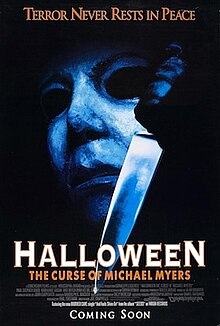
Back هالوين: لعنة مايكل مايرز Arabic Hellouin: Maykl Mayersin lənəti Azerbaijani Хелоуин 6: Проклятието на Майкъл Майърс Bulgarian Halloween: La maledicció de Michael Myers Catalan Halloween: Prokletí Michaela Myerse Czech Halloween: The Curse of Michael Myers Welsh Halloween: The Curse of Michael Myers Danish Halloween VI – Der Fluch des Michael Myers German Η Νύχτα με τις Μάσκες: Η Κατάρα του Μάικλ Μάγιερς Greek Halloween 6 - La maledizione di Michael Myers EML
| Halloween: The Curse of Michael Myers | |
|---|---|
 Theatrical release poster | |
| Directed by | Joe Chappelle |
| Written by | Daniel Farrands |
| Based on | Characters by John Carpenter and Debra Hill |
| Produced by | Paul Freeman |
| Starring | |
| Cinematography | Billy Dickson |
| Edited by | Randolph K. Bricker |
| Music by | Alan Howarth |
Production companies |
|
| Distributed by | Dimension Films |
Release date |
|
Running time | 88 minutes[2] |
| Country | United States |
| Language | English |
| Budget | $5 million[3] |
| Box office | $15.1 million (U.S.)[4] |
Halloween: The Curse of Michael Myers[i] is a 1995 American slasher film directed by Joe Chappelle, written by Daniel Farrands, and starring Donald Pleasence, Paul Rudd, Marianne Hagan, and Mitch Ryan. The sixth installment in the Halloween film series,[5] the plot depicts Michael Myers hunting down the infant son of his niece, Jamie Lloyd.[6] It expands significantly upon the supernatural horror elements that were sparsely introduced in the previous film, mainly the subplot of a cult that controls Myers and drives him to murder his bloodline using the ancient rune of Thorn. It marks the final appearance of Pleasence as Dr. Sam Loomis before his death, as well as the feature film debut of Rudd, who portrays an adult Tommy Doyle from the original Halloween (1978). This also marks the last major role of George P. Wilbur before his death in 2023.
Halloween: The Curse of Michael Myers had a protracted development that spanned several years, comprising numerous revisions, drafts, and contributions from different screenwriters, including Daniel Farrands and Scott Rosenberg. Farrands ultimately completed the final version of the screenplay shortly before filming began in Salt Lake City in the fall of 1994. The film also had a troubled post-production: Its original cut performed poorly with test audiences, leading to the film undergoing a series of reshoots and edits. The finished film was distributed by Dimension Films, who would go on to distribute the rest of the series until 2018's Halloween. Pleasence died on February 2, 1995, nearly eight months before the film was released. The film was dedicated to his memory.
Halloween: The Curse of Michael Myers was released on September 29, 1995, grossing $15.1 million at the domestic box office on a budget of $5 million. It was lambasted by critics, with criticism focused on its weak story, ending, Rudd's performance, and the origin story given to Michael Myers, though Pleasence's performance was better received. After the film's home media release, the original workprint of the film, which featured 45 minutes of alternative footage and a different ending, was discovered by fans of the series. This version, dubbed the Producer's Cut, developed a cult following, with bootleg DVD copies sold on eBay and online petitions targeting for an official release of it.[7] In September 2014, the Producer's Cut received its first official home media release by Scream Factory as part of a Blu-ray box set of the Halloween series.[8]
Halloween: The Curse of Michael Myers was followed by Halloween H20: 20 Years Later in 1998, which does not contain any references to the Jamie Lloyd storyline of the prior three films (although they were featured in the original script and comic book tie-ins published by Chaos! Comics), instead serving as a direct sequel to Halloween II (1981).
- ^ "Halloween: The Curse of Michael Myers". British Film Institute. Archived from the original on October 22, 2023.
- ^ a b Etling 2014, p. 200.
- ^ "Halloween 6: The Curse of Michael Myers (1995)". Filmsite.org. Retrieved May 3, 2019.
- ^ "Halloween: The Curse of Michael Myers Financial Information". Box Office Mojo. Retrieved May 3, 2019.
- ^ Norman 2014, p. 180.
- ^ Rogers 2003, p. 110.
- ^ "Halloween 6, The Producer's Cut". Arrow in the Head. Archived from the original on December 18, 2007.
- ^ "Full Specs For 'Halloween: The Complete Collection'!!". Bloody Disgusting. July 21, 2014. Archived from the original on April 30, 2023.
Cite error: There are <ref group=lower-roman> tags or {{efn-lr}} templates on this page, but the references will not show without a {{reflist|group=lower-roman}} template or {{notelist-lr}} template (see the help page).